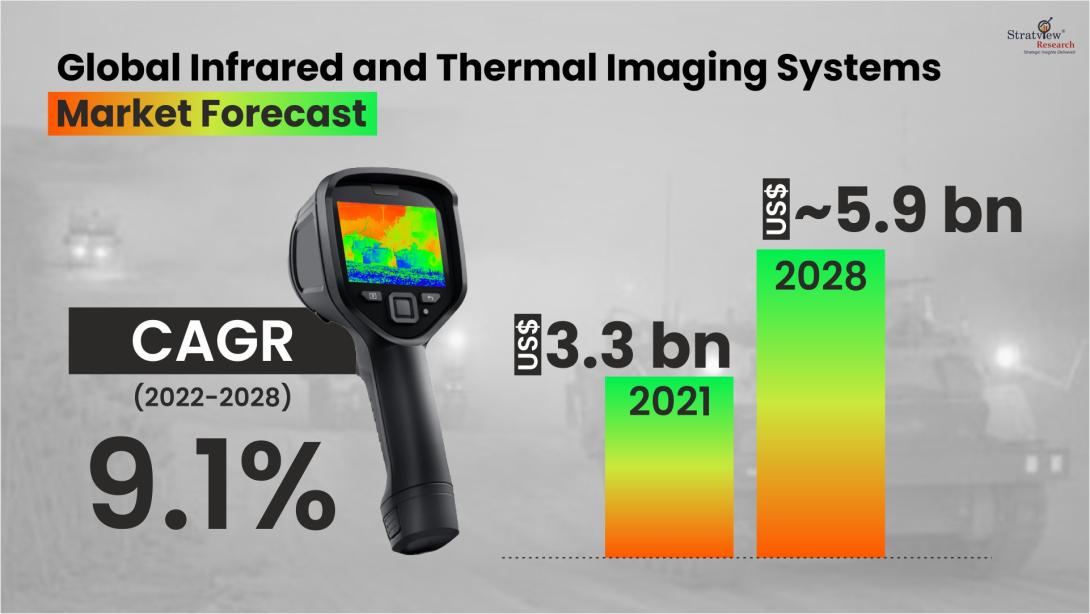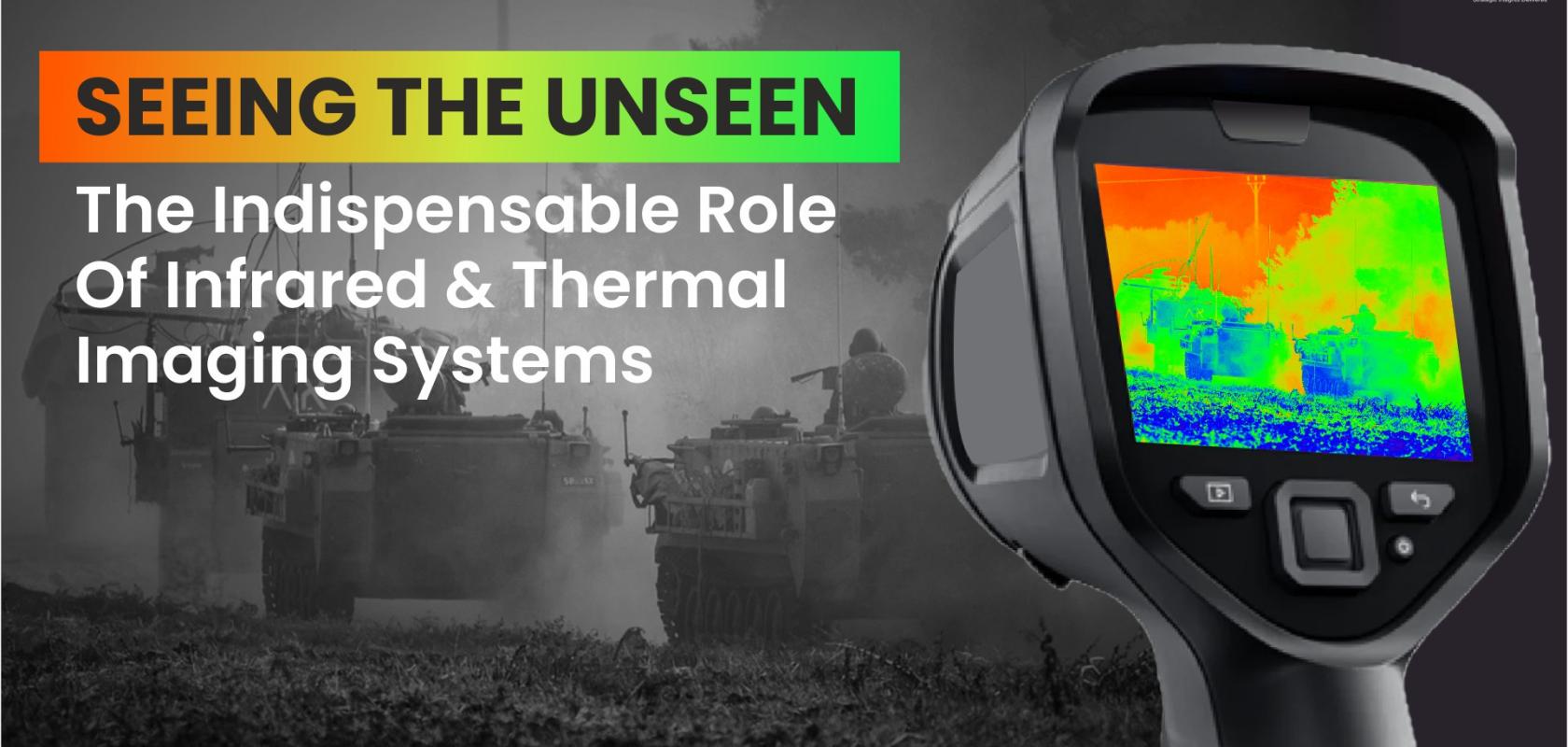This industry report from Stratview Research highlights the many innovations, applications and use cases for infrared and thermal imaging solutions.
In a world where the unseen often poses the greatest threats, infrared and thermal imaging systems appear as silent guardians, illuminating the darkness with their unique vision. Be it a firefighter who navigates through thick smoke, relying on a handheld thermal camera to locate a trapped individual, or some military operation where soldiers are equipped with thermal imaging technology that scans their surroundings, piercing through the dark night to identify potential threats invisible to the human eye, infrared and thermal imaging systems are essential tools for enhancing safety and operational effectiveness across various fields.
These remarkable technologies have woven themselves into the fabric of our daily lives, enhancing safety in our homes and workplaces while simultaneously serving as critical tools in military operations. From detecting heat leaks to guiding precision strikes in combat zones, infrared and thermal imaging systems are redefining how we perceive and interact with our environments.
As advancements continue to expand, these systems promise not only to deepen our understanding of the world around us but also to expand their utility across both civilian and military domains.
Applications of infrared and thermal imaging systems
Every object above absolute zero emits some level of heat, and thermal cameras capture that heat energy as infrared light. Infrared and thermal imaging is a process of using thermal imagers to ‘see’ heat-emitting objects, even with poor visibility conditions or complete darkness, with a common example being night-vision glasses used to detect objects in the dark.
Infrared thermal imaging technology is becoming increasingly popular in various fields including security, healthcare, the petroleum industry, construction sectors, transportation, environmental protection (such as forest fire prevention) and others, finding specific applications in:
- Surveillance and enhanced public safety in smart cities
- Identifying areas with poor insulation and other energy inefficiencies
- Traffic management systems to monitor and control traffic flow
- Environmental monitoring to respond promptly to mitigate risks and protect natural resources
- Healthcare and public health to screen individuals for elevated body temperatures
Infrared thermal imaging is undeniably a cornerstone technology in the evolution of various industries.
Infrared thermal imaging for military surveillance
The infrared and thermal imaging systems used today are based on technology originally developed for military purposes. Military IR thermal cameras are used for a range of applications including patrolling, weapon targeting, surveillance, detecting human targets, vehicles and more. These systems enable the military to assess potential threats and act in a timely and effective manner.
As threats grow more complex and modern warfare becomes fast-moving and intense, global armies are modernising their military arsenal by equipping soldiers with the latest surveillance technologies, including optronics systems like IR thermal imaging devices.
The Russia-Ukraine war highlights the active use of thermal imaging technology. Ukraine has been at war with Russia since 2014 and is leaving no stone unturned to strengthen its defence capabilities. Ukraine used thermal imaging to locate mines placed by Russian forces intended to slow down or injure its troops.
In a war-torn country like Ukraine, drones enhance defence capabilities. The military is focusing on developing its drone production and associated equipment to ensure victory in the war. Odd Systems—a Ukrainian company specialising in manufacturing first-person view (FPV) drones—is developing a new drone thermal imaging camera that will provide clear images of the battlefield, even in low-light conditions. Additionally, the price of these devices will be significantly cheaper than other available options at approximately $270 per unit, according to the company.
In August 2024, Compass Engineering—a Ukrainian company—donated a new thermal imaging device with a screen to help detect Shaheds—unmanned combat aerial vehicles (UCAVs). This device can detect Shaheds at distances up to 5km.
Russians are constantly using naval aviation to protect their fleet and coastal facilities from Ukrainian unmanned vessels. To counter Ukrainian naval drones, the Russian Black Sea Fleet is developing thermal imaging systems for use in FPV drones launched from helicopters.
Another thermal imaging system called ‘Vzglyad’ can detect human figures at distances up to 300m and recognise equipment at distances up to half a kilometre. Developed by the Vologda Optical-Mechanical Plant (VOMZ), the Vzglyad is designed for transport applications; it is mounted on vehicle roofs to provide improved visibility. It uses infrared imaging technology with a matrix resolution of 640x512 pixels and displays real-time information on a monitor located in front of the driver. Plans are underway for mass production of the Vzglyad thermal imaging system, targeting an output of up to 100,000 units annually. Meanwhile, Israeli defence giant Elbit is adapting thermal imaging technology originally designed for night vision in combat, for medical applications, showcasing its versatility beyond the battlefield.
Growth factors boosting the global market
The market for infrared and thermal imaging systems is interlinked with several industries due to widespread usage across sectors. Additionally, rising demand for advanced surveillance solutions across public and private sectors—including military and defence—contributes to the increased adoption of thermal imaging technologies.
Due to such widespread usage, mass production leads to decreased prices for thermal cameras. Consequently, cost reduction plays a vital role in adopting these systems. A major reason for demand growth can be attributed to rising military spending globally. Investments in advanced thermal imaging solutions for combat operations contribute significantly to growth in the global IR thermal imaging systems market.
Innovations driving future applications
Infrared and thermal imaging technologies have undergone remarkable transformations, evolving from elementary devices into sophisticated systems that enhance safety and efficiency across various sectors. This evolution is marked by innovations such as high-definition infrared cameras, the miniaturisation of sensors, artificial intelligence (AI)-powered analytics and more. These innovative systems utilise advanced technologies to capture clearer real-time thermal images.
Launched on August 16th, 2024, for example, the Electro Optical-Infrared (EOIR) payload aboard the Indian Space Research Organisation’s (ISRO) latest Earth Observation Satellite (EOS-08), represents a significant innovation in thermal imaging technology. Developed by the ISRO’s Space Applications Center (SAC-ISRO), EOIR features advanced mid-wave infrared (MIR) and long-wave infrared (LWIR) channels for high-resolution thermal imaging.
Meanwhile, in July 2024, engineers at the University of Houston developed highly sensitive infrared thermometers and thermal cameras that can measure the continuous spectrum of light, without direct contact with the subject being photographed. This new method overcomes challenges faced by conventional thermal imaging by eliminating wavelength and temperature dependency, making them valuable tools across various fields including military security, mechanical inspections, police surveillance and medical diagnostics.
To reference a medical diagnostic application, more than 540 million individuals globally are affected by diabetes; for them, non-invasive methods of measuring blood glucose levels (without piercing the skin) would be a great relief. DiaMonTech AG—a German-based company—is set to launch its innovative mid-infrared laser technology that can scan tissue fluid beneath the skin, and analyse it for glucose molecules. While this technology is already available as a desktop device, the company is working on launching a smartphone-sized instrument soon. As miniaturisation without loss of quality presents challenges, DiaMonTech uses Ophir Pyrocam to measure all laser developments.
With ongoing advancements paving the way for new applications, the future of infrared and thermal imaging systems looks promising. Soon, thanks to new ultra-thin materials discovered by researchers in Australia, we may have everyday glasses with integrated night vision capabilities, for example. Manufactured using meta-surface-based up-conversion technology, the researchers have found ways to achieve night vision effects, without the use of bulky light-processing equipment.

Image: Stratview Research
The future of infrared thermal imaging systems
The journey of infrared and thermal imaging is just beginning; with a global market value of ~$3.3bn in 2021, its impact will resonate far beyond what we can see. Technological expansion coupled with widespread adoption across various industries indicates that market value will grow at an annual rate exceeding 9% from 2022 to 2028—reaching $5.9bn by 2028.
In recent years, infrared technology has undergone further innovation through its integration with other cutting-edge technologies. For example, fusing infrared imaging with artificial intelligence has enhanced surveillance system capabilities—enabling automated threat detection and tracking.
Additionally, advancements in miniaturisation have made infrared cameras more compact and portable, opening up new possibilities in fields such as drones and wearable devices.
The journey from night vision to thermal imaging represents a remarkable evolution in infrared technology; what began as an effort to see in darkness has developed into diverse applications touching nearly every aspect of our lives.


